Objects : 132
-
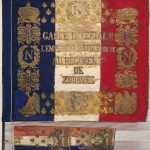 Object / 2nd Republic / 2nd EmpireThe flag of the Zouaves regiment of the Imperial Guard, 1854 model
Object / 2nd Republic / 2nd EmpireThe flag of the Zouaves regiment of the Imperial Guard, 1854 modelFrom one Empire to another After the fall of the Empire in 1815, Napoleonic emblems were banned. The Eagle and the Tricolour flag were no longer to be brandished by the army, to be replaced by the Fleur de lys and the white flag of the Bourbons. During the July Monarchy, the Tricolour was rehabilitated […]
-
 Object / IIe République – 2nd Empire/2nd Republic-2nd Empire‘La Danse’: Carpeaux’s sculpture for the façade of the Opéra Garnier
Object / IIe République – 2nd Empire/2nd Republic-2nd Empire‘La Danse’: Carpeaux’s sculpture for the façade of the Opéra GarnierIn 1861, to many people’s astonishment, the young architect Charles Garnier (1825-1898) won the competition to design a new opera house in Paris. The project was launched by Napoleon III a short while after Orsini’s attack of 14 January 1858, when the latter had attempted to assassinate the Imperial Couple as they arrived for a […]
-
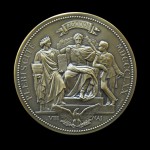 Object / 2nd Republic / 2nd Empire, IIe République – 2nd Empire/2nd Republic-2nd EmpirePlebiscite of 8 May 1870: Medal bearing the portraits of Napoleon III and Napoleon Eugène Louis, Prince Imperial
Object / 2nd Republic / 2nd Empire, IIe République – 2nd Empire/2nd Republic-2nd EmpirePlebiscite of 8 May 1870: Medal bearing the portraits of Napoleon III and Napoleon Eugène Louis, Prince ImperialThe Napoleonic regime was essentially autocratic and popular, and from the Consulate period onwards, plebiscites or referenda were organised so that civil society could give its opinion on matters of constitutional law, namely: – on the establishment of the Consulate in 1799 after the coup d’état of 18 Brumaire (plebiscite of 7 February 1800), – […]
-
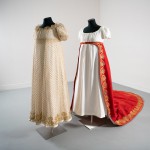 Object / Directoire-Consulat-Ier Empire/Directory-Consulate-1st Empire, Directory / 1st EmpireMadame Bérenger’s court dress and train
Object / Directoire-Consulat-Ier Empire/Directory-Consulate-1st Empire, Directory / 1st EmpireMadame Bérenger’s court dress and trainThere is one reality that hasn’t changed in over two hundred years: fashion comes and goes due to appearances (or lack of them) in fashion magazines. During the Empire, the one that was in the hands of all the women of the court was the Journal des dames et des modes (All the illustrations can […]
-
 Object / Consulate, Directory / 1st EmpireSabre of Honour awarded to Jean-Baptiste Bessières by Napoleon Bonaparte for his role on 19 Brumaire
Object / Consulate, Directory / 1st EmpireSabre of Honour awarded to Jean-Baptiste Bessières by Napoleon Bonaparte for his role on 19 BrumaireWeapons of honour In 1791 the National Constituent Assembly disposed of royal military honours and replaced them with their own Décoration Militaire. Then, on 21 September 1792, the Convention abolished the monarchy and with it the Décoration Militaire (officially abolished on 15 October 1792), which was in effect a direct descendent of the Ancien Régime. […]
-
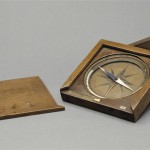 ObjectNapoleon Bonaparte’s compass when he was at the École Royale Militaire in Brienne
ObjectNapoleon Bonaparte’s compass when he was at the École Royale Militaire in BrienneThe compass was brought to Europe by the Arabs during the Mediaeval period, it rapidly became an essential tool for soldiers and sailors alike, achieving almost a supernatural, almost magical status. In the 13th century, the scientist Pierre de Mauricourt studied the physics of magnets, becoming the first to establish a link between compasses and […]
-
 Object / Directoire-Consulat-Ier Empire/Directory-Consulate-1st EmpireBust of Pius VII
Object / Directoire-Consulat-Ier Empire/Directory-Consulate-1st EmpireBust of Pius VIIThis bust of the Pope who consecrated Napoleon I, made by Antonio Canova, is held at the Château de Versailles. The marble likeness echoes the Pope’s brief visit to Louis XIV’s château, on 3 January 1805 (see here an account of the Pope’s visit to Versailles). Pius VII had been invited to Paris by Napoleon to […]
-
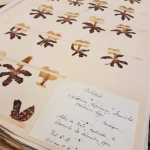 ObjectPrince Bonaparte’s Herbarium
ObjectPrince Bonaparte’s HerbariumThe University Claude Bernard Lyon 1 (FR-CERESE) carried out a crowdfunding campaign in the spring of 2018 in order to supplement the funding that the eReCoNat programme had obtained for the digitisation of Prince Roland Bonaparte’s exceptional herbarium. A 13m-long industrial scanning bench was installed amongst the herbarium’s antique furniture in order to digitise the […]
-
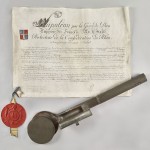 ObjectCharles Bouge’s Baron d’Empire Diploma with the imperial seal and case
ObjectCharles Bouge’s Baron d’Empire Diploma with the imperial seal and caseThis “Baron d’Empire” diploma was granted to Colonel Charles Bouge at the end of March 1808 and confirmed in January 1809. He was in the first wave of Barons d’Empire, the title having been created on 1 March 1808. Charles Bouge embraced the French Revolution: he was captain in the 2nd Battalion of Volunteers of […]
-
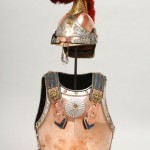 ObjectThe Fondation Napoléon’s French Carabinier* Officer’s Helmet and Cuirass (1811 and 1815)
ObjectThe Fondation Napoléon’s French Carabinier* Officer’s Helmet and Cuirass (1811 and 1815)Description * Similar to Dragoon Guards in the British Army Wrought iron cuirass (2 – 3 mm) of the same type as that used by French cuirassiers, plated (up to 25 mm from the edge) with “red brass” (= copper). The cuirass comprises a breast- and back-plate, joined by shoulder parts. The breastplate (“plastron” in […]

